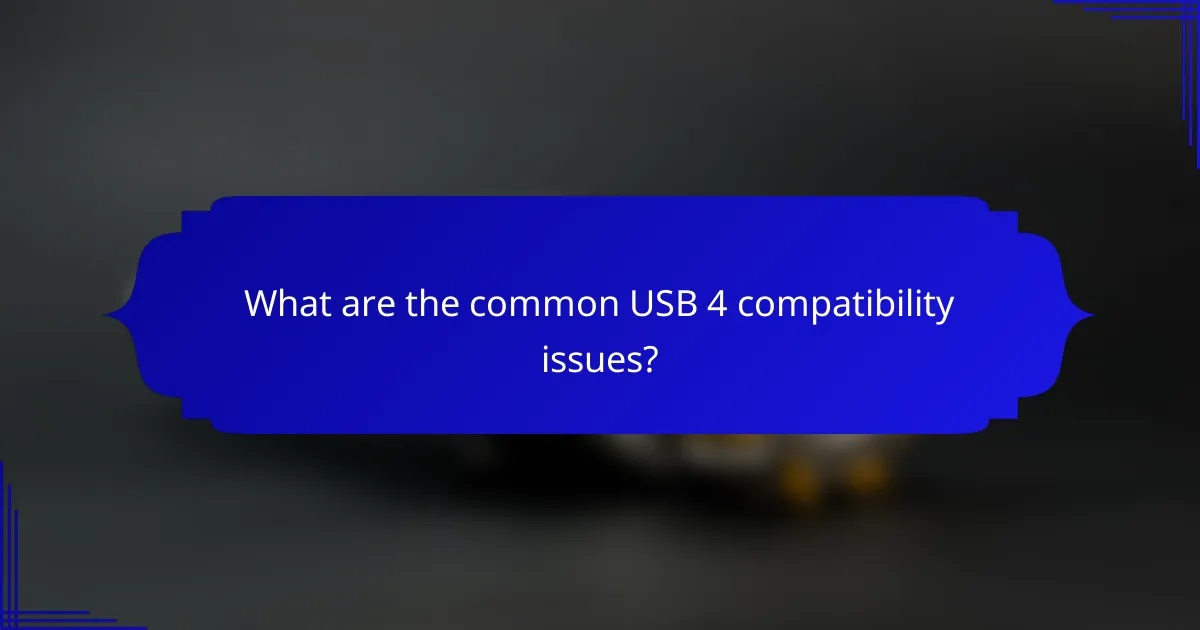USB 4 technology offers impressive speed and versatility, but compatibility issues can hinder its performance. Users may encounter connection failures or limitations due to differences in device standards, making it essential to understand potential pitfalls. By following troubleshooting steps such as checking cable quality and ensuring device updates, users can enhance their USB 4 experience and avoid common mistakes.

What are the common USB 4 compatibility issues?
USB 4 compatibility issues often arise from differences in device standards, leading to performance limitations or connection failures. Understanding these issues can help users troubleshoot effectively and ensure optimal device performance.
Incompatibility with USB 3.2 devices
USB 4 is designed to be backward compatible with USB 3.2, but not all USB 3.2 devices will function seamlessly with USB 4 ports. Users may experience reduced speeds or limited functionality when connecting older devices, as USB 4 utilizes different protocols that may not support legacy features.
To avoid issues, check the specifications of your USB 3.2 devices and ensure they are compatible with USB 4. If possible, use devices that explicitly state compatibility with USB 4 to ensure optimal performance.
Limited support for older peripherals
Many older peripherals, such as printers and external hard drives, may not support USB 4, leading to connection problems. These devices often rely on older USB standards, which can result in incompatibility with the new USB 4 architecture.
When using older peripherals, consider upgrading to newer models that support USB 4 or using adapters that can bridge the gap between different USB standards. Always verify compatibility before making a purchase.
Firmware update requirements
Some USB 4 devices may require firmware updates to function correctly with the latest technology. Manufacturers often release updates to enhance compatibility and performance, so keeping your devices updated is crucial.
Check the manufacturer’s website for firmware updates regularly. This can prevent potential issues and ensure that your devices operate at their best, particularly when connecting to USB 4 ports.
Power delivery discrepancies
USB 4 supports enhanced power delivery capabilities, but not all devices can handle the increased power output. This can lead to charging issues or device malfunctions if a device is not designed to manage the higher wattage.
To avoid power delivery problems, use certified cables and chargers that are compatible with USB 4 specifications. Be cautious when connecting devices with varying power requirements to ensure safe and effective charging.

How to troubleshoot USB 4 connection problems?
To troubleshoot USB 4 connection problems, start by checking the quality of your cables and ensuring that your devices are updated. Common issues often stem from incompatible cables or outdated drivers, so addressing these areas can resolve many connectivity issues.
Check cable quality and specifications
Ensure that your USB 4 cables are certified and meet the required specifications for optimal performance. Look for cables that are labeled as USB 4 or Thunderbolt 3/4, as these will support the necessary data transfer rates and power delivery.
Inspect the cable for any visible damage, such as fraying or bent connectors, which can hinder connectivity. If possible, test with a different cable to determine if the original is the source of the problem.
Update device drivers
Outdated drivers can lead to compatibility issues with USB 4 devices. Check for updates from your device manufacturer’s website or through your operating system’s update utility to ensure you have the latest drivers installed.
Regularly updating your drivers can prevent many connection problems. Consider enabling automatic updates for your operating system to keep all drivers current without manual intervention.
Test with different ports
If you experience connection issues, try using different USB ports on your device. Some ports may not support USB 4 or may be malfunctioning, so switching ports can help identify the problem.
Additionally, check if the ports are clean and free from debris, as dirt can obstruct connections. If you have multiple devices, test them on various ports to see if the issue persists across all connections.
Reset device settings
Resetting device settings can resolve configuration issues that affect USB 4 connectivity. This can typically be done through your device’s settings menu, where you can restore default settings without losing personal data.
Before resetting, back up any important configurations or data. After the reset, reconnect your USB 4 devices to see if the problem is resolved, and reconfigure any necessary settings as needed.

What are the common pitfalls when using USB 4?
Common pitfalls when using USB 4 include using non-certified cables, ignoring device compatibility lists, and overlooking power requirements. These issues can lead to performance problems, connectivity issues, and even damage to devices.
Using non-certified cables
Using non-certified cables can result in suboptimal performance or complete failure to connect. USB 4 requires specific standards for data transfer speeds and power delivery, which non-certified cables may not meet. Always opt for cables that are certified for USB 4 to ensure compatibility and reliability.
Look for cables that explicitly state they support USB 4 specifications. This can help avoid issues like slower data transfer rates or insufficient power delivery to connected devices.
Ignoring device compatibility lists
Ignoring device compatibility lists can lead to frustration and wasted time. Not all devices support USB 4, and even among those that do, there may be variations in functionality. Always check the manufacturer’s compatibility list before purchasing or connecting devices.
For example, a USB 4 hub may work with some devices but not others, depending on their specifications. Ensuring compatibility can save you from connectivity issues and ensure optimal performance.
Overlooking power requirements
Overlooking power requirements is a common mistake that can affect device performance. USB 4 can deliver significant power, but not all devices can handle the same power levels. Make sure to verify the power needs of your devices and the capabilities of your USB 4 ports.
For instance, some devices may require higher wattage for charging or operation, while others may only need minimal power. Using a USB 4 hub that does not meet these requirements could lead to inadequate power supply and potential device malfunctions.

What prerequisites should be met for USB 4 usage?
To effectively use USB 4, ensure that your devices have the latest firmware and meet specific hardware specifications. Compatibility is crucial for optimal performance and functionality.
Device firmware must be up to date
Keeping device firmware updated is essential for USB 4 compatibility. Manufacturers often release updates that enhance performance, fix bugs, and improve compatibility with new standards.
Check your device settings or the manufacturer’s website for firmware updates regularly. Failing to update can lead to issues such as reduced data transfer speeds or connectivity problems.
Compatible hardware specifications
USB 4 requires specific hardware capabilities, including support for Thunderbolt 3 and USB 3.2. Ensure that your computer, peripherals, and cables are designed to meet these specifications for seamless operation.
For example, using a USB 4 cable with a device that only supports USB 3.1 may limit functionality. Always verify that your hardware components are compatible with USB 4 to avoid performance bottlenecks.

How does USB 4 compare to previous versions?
USB 4 significantly enhances performance compared to earlier USB versions, particularly in data transfer speeds, power delivery, and video output capabilities. It integrates Thunderbolt 3 compatibility, allowing for a more versatile and efficient connection across devices.
Higher data transfer rates
USB 4 supports data transfer rates of up to 40 Gbps, which is double the maximum speed of USB 3.2. This increase allows for faster file transfers and improved performance when using multiple devices simultaneously.
To fully utilize these speeds, ensure that both the cable and connected devices support USB 4. Using older cables or devices may result in slower transfer rates, limiting the benefits of the new standard.
Improved power delivery capabilities
USB 4 enhances power delivery, allowing devices to receive up to 100 watts of power. This capability is particularly useful for charging laptops and powering peripherals without needing separate power adapters.
When using USB 4 for charging, verify that your devices and cables are compliant with the USB Power Delivery specification to avoid potential damage or inefficiencies.
Enhanced video output options
USB 4 supports multiple video protocols, including DisplayPort and HDMI, enabling higher resolutions and refresh rates. This feature allows users to connect multiple displays or high-resolution monitors seamlessly.
For optimal video output, check that your devices are compatible with the required video standards and that you are using the appropriate cables to support the desired resolution and refresh rate.

What are the future trends in USB technology?
The future of USB technology is marked by the widespread adoption of USB 4, which promises enhanced speed and versatility. As more devices integrate this standard, users can expect improved compatibility and performance across a variety of applications.
Integration of USB 4 in more devices
USB 4 is increasingly being integrated into a wide range of devices, including laptops, smartphones, and peripherals. This integration allows for faster data transfer rates, potentially reaching up to 40 Gbps, and supports multiple protocols, enhancing overall device functionality.
As manufacturers adopt USB 4, users should be aware of compatibility issues with older USB standards. Devices that support USB 4 are generally backward compatible, but performance may vary depending on the specific USB version of the connected device.
Adoption of universal cables
The trend towards universal cables is gaining momentum with the rise of USB 4. These cables are designed to work across various devices, reducing the need for multiple types of connectors and simplifying the user experience.
When selecting universal cables, ensure they are certified for USB 4 to take advantage of the higher data transfer speeds and power delivery capabilities. Avoid using non-certified cables, as they may lead to performance issues or damage to your devices.
